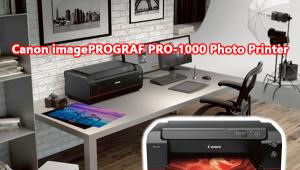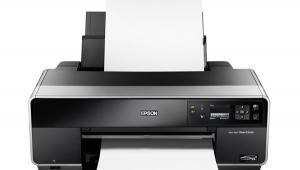Epson’s Stylus Photo R1900; Color Enthusiasts Take Note
Challenge is good, and Epson's new 13" Stylus Photo R1900 presents a challenge to those who want it all--great color and great black and white printing. Its color output equals anything in the Epson line-up, while black and white is less advanced, perhaps because its target is the photo enthusiast seeking colorful, high-quality, long-lasting prints.
 |
The new ink set is referred to as UltraChrome Hi-Gloss 2, and it differs from most Epson combinations in offering a Gloss Optimizer cartridge. The cartridge holds a clear resin polymer applied to glossy or semigloss papers. (You can select "No Gloss" in the print setup.) The Gloss Optimizer in the R1900 is one of eight cartridges that also includes yellow, magenta, red, orange, cyan, photo black, and matte black.
The gloss coat helps protect your image from airborne pollutants and prevents "gloss differential." All Epson pigment inks surround the bits of color with resin, a process called micro-encapsulation. This is like the gloss coat, except it only works where ink is applied. If portions of your image are blown out to paper white, or you're printing a poster with blank spaces, no resin reaches those spots. Holding the print up to a light reveals a difference in reflectivity--the gloss differential. The R1900 eliminates this effect as long as you select "Gloss" in the printing menu.
 |
|
 |
|
|
Epson's K3 ink set printers, which use eight colors at a time, require that you replace photo black with matte black when using matte papers. This must be physically swapped out with older models such as the 2400--with more advanced models, like the 3800, the printer does so automatically when you choose a matte surface and other "art" papers in the profile, as both ink carts sit within the printer.
Using droplets as small as 1.5 picoliters, the R1900 lays down smoother gradations than Epson's K3 printers, whose droplets are at least 3 picoliters. According to Epson's design team, the human eye can discern a 3-picoliter droplet on paper but not a 1.5-picoliter droplet. So, with the R1900's tiny droplets, you see only color gradations, never color dots. K3 printers use "light" and "light light" hues to produce an equivalent effect.
The bottom line is--for color printing--the R1900's UltraChrome Hi-Gloss 2 inks edge the K3 ink set and do well when matched against Epson's latest, the UltraChrome K3 Vivid Magenta set.
 |
 |
|
|
||
The Orange Effect
What's with the R1900's orange cartridge? If you've used an Epson R1800, you'll recall a blue cartridge but no orange. Epson engineers noticed that blue was not used quickly on the R1800. They ran ink combinations on a supercomputer until they arrived at an optimal set, yielding not only a wide gamut for the R1900 but also the ability to resist color shifts under varied lighting.
















































